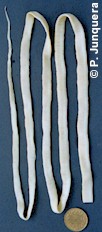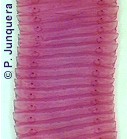Tapeworms, also called cestodes, are a class of parasitic worms (helminths) that have a flat, ribbon-like body and live in the digestive system of their hosts. Some species can be as long as 50 meters. Together with the flukes (= Trematodes) they belong to the group of flatworms (= Platyhelminthes).
All tapeworms are obligate parasites, i.e., they cannot complete development without parasitizing their hosts.

Tapeworms have a characteristic anatomy. The body consists in a head called scolex, followed by a neckpiece and a linear chain of segments called proglottids (or metamers). All the segments together form the strobila. The segments are flat and altogether the strobila looks like a tape, which is why they are called "tapeworms". Tapeworms show a visual segmentation, but it is not comparable to the segmentation of other animals such as insects, earthworms, etc.
Tapeworms have neither a digestive tube, nor circulatory or respiratory systems. They don't need them because each proglottid absorbs what it needs directly through its tegument. They have a rudimentary nervous system.
The proglottids of tapeworms increase in size from head to tail, i.e. the head is not in the widest but in the narrowest end of the body.
The scolex is armed with suckers and hooks for attaching to the host's tissues. The neckpiece produces new proglottids constantly. Each new proglottid produced pushes the older ones towards the tail. Each proglottid has its own digestive system, reproductive organs of both sexes (i.e. they are hermaphroditic) and excretory cells known as flame cells (protonephridia).
The reproductive organs in each proglottid have a common opening called the genital pore. In young proglottids all these organs are still rudimentary. They develop progressively, which increases the size of the proglottid as it moves towards the tail. Mature gravid proglottids are full of eggs and detach from the strobila to be shed outside the host with its feces.
Infections with tapeworms are called cestodosis or taeniasis (also teniasis).
A few tapeworm species can be very harmful (e.g. Echinococcus granulosus, the hydatid tapeworm) for livestock, pets and humans. However, as a general rule most tapeworm species are less of a problem for livestock and pets than roundworms.
In this site you can find additional general information on parasites and on parasitic worms.
Life cycle of tapeworms
Tapeworms have indirect life cycles that require the passage through at least one intermediate host (insects, mites, other mammals) where the various developmental stages suffer considerable morphologic changes.
In most species mature proglottids release the microscopic eggs still inside the host. The eggs are shed with the host's feces. In some tapeworm species the whole mature proglottid is expelled and the eggs are released only outside the host. Such gravid proglottids are sometimes visible to the naked eye and look like rice grains in the excrements of the host.

Released eggs are not directly infective for the final host. Inside each egg an embryo develops that is called the oncosphere. It has three pairs of hooks. Intermediate hosts ingest such embryonated eggs. Inside these hosts, larvae (called hexacanths) hatched out of the eggs in the intestine, go through the intestinal wall and undertake a more or less complex migration inside the intermediate hosts. They develop to a further larval stage called cysticercoid (or metacestode), which has a species-specific anatomy. Cysticercoids become encysted in the tissues of the intermediate host. Encysted cysticercoids of some species are also known as bladder worms.
When the final host ingests an infected intermediate host (or its remains), the young worms are released from the cysts and complete development to adults. They attach to their predilection sites and start producing segments (proglottids).
Tapeworms are often less harmful for their final hosts than for intermediate hosts. Whereas adult tapeworms in the gut of the final host compete for nutrients and weaken the host, immature tapeworms (cysticercoids) in the intermediate host can be live threatening because they affect vital organs (e.g. the brain, the lungs, etc.). This is the case e.g. for Echinococcus granulosus, the hydatid tapeworm that has dogs and other canids as final hosts, and many other mammals (e.g. cattle, pigs, sheep and humans) as intermediate hosts where they cause the appearance of hydatid cysts.
Other tapeworm species are not live threatening for the intermediate hosts but have a serious economic impact because infected carcasses are rejected at slaughter. This is the case for cysticercosis caused by several tapeworm species of the genus Taenia that have humans or dogs as their final host, and other animals as intermediate hosts, e.g.:
- Cysticercus bovis of cattle caused by Taenia saginata (humans as final hosts)
- Cysticercus cellulosae of pigs caused by Taenia solium (humans as final hosts)
- Cysticercus tenuicollis of livestock caused by Taenia hydatigena (dogs as final host)
- Cysticercus ovis of sheep and goats caused by Taenia ovis (dogs as final host)
Tapeworm species of veterinary importance
The list below includes those tapeworm species that are most relevant for cattle, sheep, pig, poultry, horses, dogs and cats. For each species the preferred location and most affected hosts are mentioned. For specific articles on each species clik the corresponding link in the list below or use the site map.
- Amoebotaenia cuneata = sphenoides, small intestine; poultry
- Anaplocephala spp, small and large intestine; horses, donkeys
- Avitellina centripunctata, small intestine; sheep, goats, occasionally cattle
- Choanotaenia infundibulum, small intestine; poultry
- Cysticercus bovis, beef measles, muscles; cattle
- Cysticercus cellulosae, the pork bladder worm, muscles; pigs
- Cysticercus ovis, sheep measles, heart and muscles; sheep, goats
- Cysticercus tenuicollis, abdominal organs; sheep, goats, pigs, horses, donkeys
- Davainea proglottina, the minute tapeworm, small intestine; poultry
- Dipylidium caninum, the flea taperworm, small intestine; dogs and cats
- Echinococcus granulosus, the hydatid worm, small intestine in dogs; liver and lungs in cattle, sheep, goats, pigs, horses, donkeys
- Echinococcus multilocularis, the small fox tapeworm, small intestine; dogs and cats
- Mesocestoides spp, small intestine; dogs and cats
- Moniezia spp, the sheep tapeworm, small intestine; sheep, goats, cattle
- Paranoplocephala spp, small and large intestine; horses, donkeys
- Raillietina spp, small intestine; poultry
- Stilesia hepatica, the liver tapeworm, biliary ducts; sheep, goats, occasionally cattle
- Taenia spp, small intestine; dogs and cats
- Thysanosoma actinioides, the fringed tapeworm, biliary and pancreatic ducts, small intestine; sheep, goats, occasionally cattle